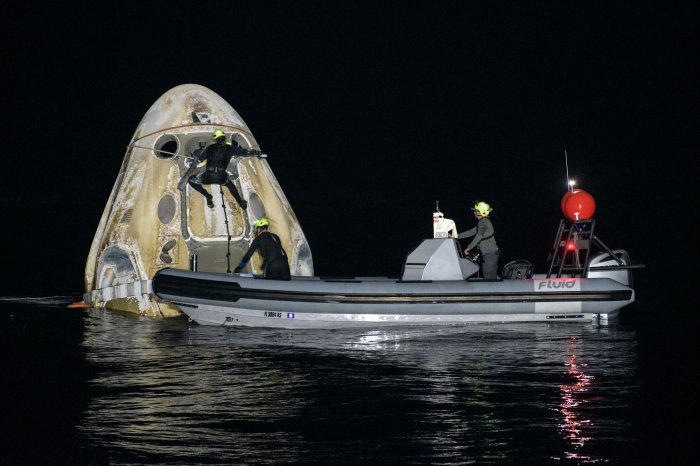SpaceX launches a number of Starlink satellites into orbit aboard its Falcon 9 rocket, at the Cape Canaveral Air Force Station, Fla., on August 18, 2020. SpaceX launched a similar shipment on Wednesday. File Photo by Joe Marino/UPI |
License Photo
ORLANDO, Fla., Jan. 20 (UPI) -- SpaceX launched another shipment of 60 Starlink satellites from Florida on Wednesday morning, adding to a rapidly growing cluster of high-speed broadband communications spacecraft.
The Falcon 9 rocket lifted off as planned at 8:02 a.m. EST into a cool, blue winter sky from Complex 39 at Kennedy Space Center. The satellites deployed into their intended orbit one hour and four minutes after launch, concluding the first Starlink mission of 2021.
The company also notched a new record for rocket reusability when it landed the first stage of the vehicle on a barge in the Atlantic Ocean, marking the eighth flight and landing for that booster.
"We have landed the Falcon 9 for the eighth time. This is our life leader. What an amazing morning!" said Jessie Anderson, a lead manufacturing engineer at SpaceX, during a live broadcast.
The launch boosts the number of Starlink spacecraft in orbit to about 955, as the company begins to sell broadband service in the United Kingdom. It already has rolled out Starlink service in Canada and the northern United States.
SpaceX also received permission from the Federal Communications Commission to launch 10 Starlink satellites into a polar orbit on a mission planned for Friday.
Those 10 spacecraft would be the first Starlink satellites to circle the globe around the North and South poles, said Jonathan McDowell, an astrophysicist at Harvard-Smithsonian Center for Astrophysics.
"Launching up to 520 Starlinks to a sun-synchronous polar orbit was part of the SpaceX plan as filed in April," McDowell said.
SpaceX has worked to address concerns raised by experts like McDowell about Starlink that such satellites can interrupt astronomical observations.
SpaceX provides data on the orbit of its satellites, but McDowell and others said such data doesn't allow accurate predictions of where the spacecraft will be in a week or two.
"Existing data is not good enough," McDowell said in an interview last week. "It's important both for space safety -- avoiding collisions -- and for astronomy, for sufficiently accurate prediction of when a satellite might pass through your telescope's field of view."
A similar plea for better data came recently from Moriba Jah, associate professor of aeronautical engineering at the University of Texas at Austin. He published an article asking for better data on large clusters of satellites like Starlink that are planned by other companies.
"If we want space safety and reliability, people need to be able to say I know where Starlinks will be next week, but we have no way of knowing that," Jah said in an interview.
Such data should include SpaceX's automated formula for moving Starlink satellites in case of an imminent collision, Jah said.
Support teams work around the SpaceX Crew Dragon Resilience spacecraft shortly after it landed with NASA astronauts Mike Hopkins, Shannon Walker and Victor Glover and Japan Aerospace Exploration Agency astronaut Soichi Noguchi aboard in the Gulf of Mexico off Panama City, Fla., on Sunday. Photo by Bill Ingalls/NASA |
License Photo
















